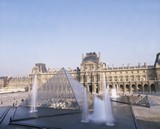 |
||||||||
| The Louvre | ||||||||
 © Photo RMN (The Louvre) |
The principal museum of
France is housed in the former palace of the kings of France in Paris.
Louis XIV and his successors feared the Parisian mob and preferred
to live at Versailles, with the result that The Louvre became something
of a white elephant. It opened to the public as the Muséum
Français in 1793, at the height of the French Revolution, and
was quickly developed into a spectacular museum by Napoleon and the
director Dominique Vivant-Denon.
Although the French were obliged to return many of the art treasures looted by Napoleon, they were able to profit from the break up of the Hamilton collection in 1882. The French authorities secured the four busts of the Seasons by Nicolas Fouquay's factory at Rouen - four of the five most ambitious works in faience or tin-glazed earthenware produced in France during the eighteenth century - at the 1882 sale. In 1953, the Comte de Bendern generously gave the two magnificent armoires or wardrobes by André-Charles Boulle, which had stood in the Long Gallery, either side of Rubens' painting of Daniel in the Lions' Den. |
|||||||
| Among the less-known Hamilton items in The Louvre is the full-length portrait of Queen Charlotte by Allan Ramsay and his studio. It hung alongside the throne at the east end of the Long Gallery, and was bought by The Louvre at the 1882 sale for the princely sum of £63. The Louvre also owns the first half of the great silver-gilt tea service of the Emperor Napoleon, which was included in one of the 1919 Hamilton Palace sales and was given to the Museum by the Société de Amis du Louvre in 1952. | ||||||||
|
|
|
|
|
|
|
|
|
|